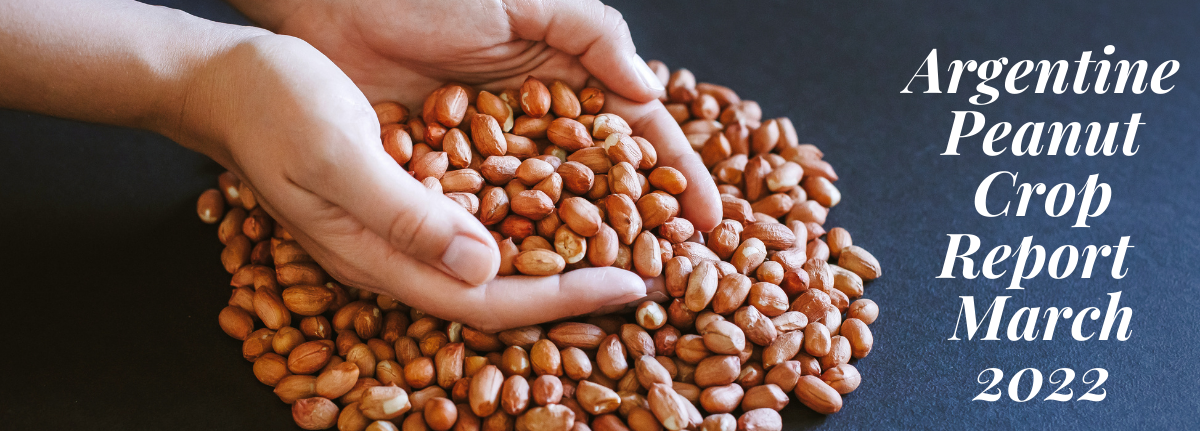
Peanut Crop Report as per March 7th, 2022
General overview
The peanut crop report at the end of the cycle indicates that the current condition is good for most of the planted areas. Despite irregular rain during January and the first half of February, rainfall during the second half of February favored a heterogeneous scenario in the different areas on our reference map, as well as within the different fields in the same area.
This context marks two very distinct situations: peanut fields ranked as good and very good, with good development to date, and peanut fields that suffer severe drought and desperately require new rainfall. The difference between these two groups is given by the available water content in the soil, as well as the erratic rainfall, benefiting fields that received sufficient rain from those that did not follow the same pattern.
The following chart features the overall crop condition as determined by our professional criterion:

According to the chart, crop evolution exceeds projections in previous reports. Nonetheless, we insist on the fact that fields lack the conditions required to repeat the yields obtained last year.
In the meantime, extended weather forecasts continue indicating erratic rainfall patterns during March.
The crop has improved growth, with good production of beginning pods and beginning seeds.
In regards to plant disease and pests, two fungicide applications have been performed to control peanut leaf spot and three applications to control isolated red spider mite foci.
The peanut crop is in the full pod and beginning seed stage (R4-R5), a time of high environmental demand (adequate rainfall and temperature).
We are going through the most critical period of plant evolution, during which future yields are defined. Consequently, adequate weather conditions are essential in the forthcoming 30 days to allow peanuts to develop their seeds and mature in due time and manner.
Gastaldi Reference Map of Peanut Areas
The main peanut areas in Argentina include the provinces of Córdoba, La Pampa, San Luis and Buenos Aires.

Rainfall and temperature analysis
Rainfall was erratic until the first half of February. After February 17, different areas were exposed to variable rainfall. The Central and Western areas on our reference map received less rain. Current levels in such areas are below historical averages for the time of the year, making the former the two most severely affected areas this season.
On the other hand, the Southern and Eastern areas received more rain, resulting in better crop performance. Additionally, available water content was higher and this offset the absence of rain in previous months.
In regards to the Northern area, fields were planted later and water demand was not as high as in the other areas, where the crop is in full reproductive development.
The following BCCBA map depicts accumulated rainfall in the province of Córdoba during February. It is worth noting the negative difference against the historical averages in the departments of Río Primero, Río Segundo, Tercero Arriba and San Martín, which account for a significant crop evolution delay compared to the other areas. Peanuts suffer mild water stress.

Likewise, we may highlight a great climate variability per area, with rain pattern anomalies compared to other years. This is in line with the main climatic models that conclude that La Niña continues as the summer trend.
During the early days of March (Saturday 5), the crop in the Central area benefited from new low-intensity rainfall (10 to 15 mm) that brought relief to the crop in this area.
In regards to temperature records, January temperatures ranged within normal values as per area statistics. Lows reached 17° C, while average highs ranged between 29 °C and 30 °C. (Source: SMN).
The record highs of January that put crops under high stress conditions are no longer considered a threat.

Extended forecast trends
The image below models the probabilities of occurrence of each event according to ENSO
(El Niño- Southern Oscillation). February 2022 ended with very low rain probability, as fulfilled. March follows the same rainfall trend as February. The occurrence of El Niño is null, but a neutral year appears from April 2022. Therefore, should the ENSO simulation model be fulfilled, the rainfall pattern would be highly erratic for the season, since they would be scarce in certain areas and abundant in others. This is distinctive of The Niña models based on a neutral year.

Available Water Content in Córdoba
Soil moisture may reach its maximum retention capacity or field capacity (by which plants extract water without difficulty). Between field capacity and the permanent wilting point stands the range that we designate Useful Water.
Available Water Content in Argentina as of 3 February 2022 vs.6 March 2022


The chart depicts that in early March, values in the peanut-growing area stand at 15% in the Northern area, 10% in the Western area and 60% in the Eastern area of useful water in the soil profile.
Field tasks
Herbicide treatments to control weeds continue in all the areas on our reference map. Additionally, manual weeding is underway to control resistant weeds.
Due to water and temperature stress, pesticide applications have been reinforced to control Red Spider Mite. In many cases, more than three applications were required due to the high incidence of this pest.

We notice the presence of S. Sclerotiorum, which is progressing at alarming levels. We estimate that several peanut lots in different areas will be dug before completing their cycle, resulting in lower yields and quality. We are closely monitoring disease progression to determine the appropriate action to minimize losses. To date, there are no treatments to curtail this disease.

Second and third preventive fungicide applications have been completed to control Peanut leaf spot. This task was performed in all the areas on our reference map, except for the fields (namely in the Central and Western areas) that have suffered the most severe water stress conditions. Presently, after light rains in these areas, fungicide applications will be resumed.
Phenological Crop Evolution
Plant phenology involves the observation, recording, and interpretation of events such as the production of leaves, flowers, and fruits. Based on these measurements, we come to the following conclusion:
By Area

General

Peanut Development Stages
| V1: first tetrafoliolate leaf V2: second tetrafoliolate leaf V3: third tetrafoliolate leaf V4: fourth tetrafoliolate leaf V – (N): one to N developed nodes on main axis | R1: beginning bloom R2: beginning peg R3: beginning pod R4: full pod R5: beginning seed R6: full seed R7: beginning maturity R8: harvest maturity |
Conclusions
The peanut crop is presently in good overall condition and the outlook is good. Yield expectations will fundamentally depend on climatic conditions in the forthcoming 20 days.
Nonetheless, yield forecasts in the Central and Western areas are lower if compared with projections in other areas. This is due to lower rainfall levels during the season. Unless it rains in the forthcoming days, we foresee significant losses, with several fields that will not be dug given the negative cost/benefit ratio. Additionally, these areas are the most severely affected by Sp. Sclerotiorum.
The remaining areas (Northern, Eastern, Central-Southern and Southern) feature a more promising outlook, highly favored by the rainfall during the season. It is worth noting that these fields also benefited from the water table contribution.
Presently, peanuts are going through the early reproductive stage of their phenological development (R4 – R5).
As always, we are attentive to short and mid-term weather forecasts, in particular at this time, since the crop is at the peak of water demand.
In the forthcoming weeks, we will rely on more elements of assessment to estimate yields per area. In spite of our promise for this report, given the developments with significant differences within the same areas, we prefer to delay our yield estimates in order to provide a substantiated forecast.





Do you have a commercial inquiry?
Other questions or comments?
lamacario@gastaldihnos.com.ar


